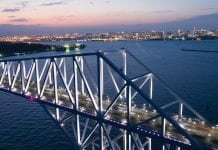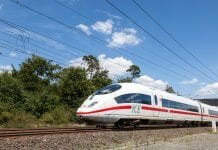
A design by Dutch company UNStudio design has won a competition to design the City of Gothenburg’s new cable car system.
City officials hope that Gothenburg’s new cable car system – which will cross the Göta River and stretch across 3km to connect public squares Järntorget and Wieselgrensplatsen – will be in place and operational in time for its planned 400th anniversary celebrations in 2021.
Dutch company UNStudio’s design for the system beat out proposals by rivals such as BIG, WilkinsonEyre, and White Arkitekter with Diller Scofidio + Renfro. The judging process was based on a number of factors, including:
- Architectural quality and design;
- Feasibility and development potential;
- Economic, administrative, environmental and social sustainability; and
- Function, logistics, and accessibility.
Now that the winning design has been chosen, a contractor will be sourced to carry out a feasibility study, which will be completed in summer 2019. Alongside this process, the city’s planning authorities will investigate how the construction and operation of the cable car system will impact the surrounding environment.
Why did UNStudio’s design win?
The installation of the SEK 1.1bn (~€111m) system will mark the first new mode of public transport to be built in the country since 1930. The winning design, dubbed ‘New Beacons’, has been seen as a contemporary interpretation of the country’s industrial legacy.
The system’s asymmetrical towers have been designed as a reference to cranes in Gothenburg’s shipyard, to recognise the city’s history of industry. In total, the new cable car system will connect four stations and six towards with a single cable car line.
In a statement, Ben van Berkel, founder and principal architect at UNStudio, outlined his company’s approach to designing Gothenburg’s new cable car system and highlighted many of the benefits it would offer.
He said: “A cable car system can not only provide much needed sustainable transport between otherwise disconnected parts of our growing cities, but by travelling ‘as the crow flies’ and bypassing traffic congestion on the ground, it can ensure extremely fast, reliable and efficient travel for both residents and visitors alike … They enable us to see and experience our cities in a whole new way.”


















